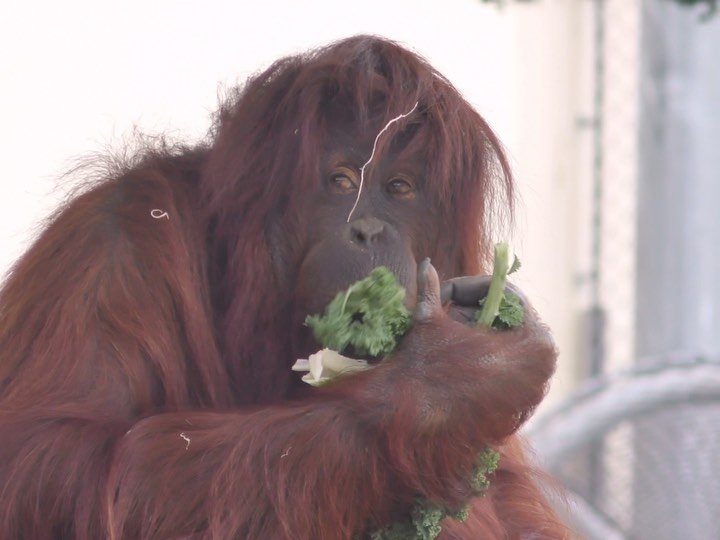– An in-depth exploration of the unique fruit-heavy diet of orangutans and its impact on their health and behavior.
– Understanding the importance of environmental enrichment through foraging opportunities for orangutans in captivity.
– A closer look at the eating habits of Judy and Berani, two orangutans with distinctive taste preferences.
– The role of diverse feeding strategies in promoting orangutans’ physical and mental well-being.
– Celebrating Orangutan Caring Week by appreciating the complex dietary needs of these remarkable primates.
When one delves into the world of our forest-dwelling cousins, the orangutans, a rich tapestry of behaviors and preferences emerges. Central to their daily existence is a delectable menu that would make any fruit enthusiast envious. These primates are passionate connoisseurs of the forest’s bounty, exhibiting dining habits that reveal much about their nature and the ecosystems they inhabit.
Imagine a feast composed of 65-90% fruit—an impressive range boasting durian, a fruit with an intense aroma yet cherished for its creamy texture; rambutan, with its hairy exterior and sweet interior; and jackfruit, whose massive size belies its subtly flavored flesh. This is but a glimpse into the daily fare of the orangutan. However, their culinary journey doesn’t end there, as their diet also includes a medley of bark, leaves, vines, flowers, and even honey they daringly acquire from bee hives perched in the lofty trees.
Amidst the lush green canvas of their natural habitat, these great apes have become astute foragers. This skill satisfies their hunger and sharpens their impressive cognitive abilities. Crafty and deliberate, they scour the canopy for nature’s sweets, their intuition guiding them to the most mouthwatering morsels. Yet, their feast is not simply a matter of taste—it is a complex dance between biology and ecology, where each bite influences both their physical health and the vitality of the forest.
In the more controlled environment of a sanctuary or zoo, diligent efforts are made to recreate the richness of their natural diet. Caretakers like those celebrating Orangutan Caring Week go to great lengths to ensure that even in captivity, these gentle giants can savor the essence of their ancestral dining habits. Here, Judy and Berani, two orangutans with a discerning palate, thrive under the diligent watch of their human stewards.
Judy, with a penchant for the rustic charm of banana leaves, and Berani, who finds delight in the pop of cherry tomatoes, have their unique favorites catered to. Their daily spread consists of a variety of fruits and a selection of vegetables and leafy greens that mirror the nutrient-dense forage available in the wild. This diverse diet is crucial, mimicking the nutritional balance that orangutans have evolved to require.
In what might seem like a Gordian Knot of tastes and textures, orangutans enjoy a degree of dietary variety essential for their physical and cognitive well-being, whether in the wild or under human care. It’s not merely about replicating a list of food items; it is about stimulating the entire foraging experience that engages their minds and bodies. To this end, puzzle feeders and barrels packed with treats catalyze enjoyment and exercise. Just as the wild demands ingenuity and effort to secure a meal, so do these gadgets challenge the apes, encouraging natural behaviors and ensuring an active lifestyle within the confines of their enclosures.
The dietary needs and the nuances of orangutan feeding are not just about sustenance but are an art form that underlines their deep connection to their environment. It is a spectacle of evolution that has honed these creatures to thrive amidst abundance and scarcity, making them adept at maximizing their nutritional intake regardless of circumstances.
Providing such an intricate and species-appropriate diet in captivity is a triumph of modern conservation efforts, highlighting an often-overlooked aspect of wildlife care. Yet, it is also a constant battle that requires an understanding of both the individual animal and the species as a whole. As we peel back the layers of their dietary desires, we also unfold the poignant story of a species whose existence is perilously tied to the forest that feeds them.
Orangutan Caring Week is an ode to these remarkable beings and an opportunity to reflect on the profound intricacies of their lives. It’s a call to recognize their needs and intrinsic worth as individuals and as a species. It is a celebration of their identity, tied irrevocably to the threads of nature’s tapestry, and a reminder of our responsibility to protect and understand the wild and the creatures within.
As Judy carefully unravels her beloved banana leaf and Berani delicately pounces on a cherry tomato with focused delight, we witness the wonder of being in harmony with nature, even when nature has to be brought within human-engineered walls. The happiness in their eyes and the satisfaction in their movements remind us that caring for orangutans—or any wildlife, for that matter—is not just a job or a duty. It is an art and a science, where every foraged barrel and puzzle feeder becomes a testament to their indomitable spirit and our enduring commitment to their care.
In celebrating Orangutan Caring Week and every week after that, let us continue to toast to the vibrancy of the orangutan’s diet and the dedicated efforts to replicating it. It is a testament to the complexity of their being and a mirror to the passion that fuels wildlife caregivers around the globe. So here’s to the fruit lovers of the forest, their keepers, and a world that still marvels at the wonders of the wild and the beauty of the beings that call it home.
*****
Source Description
Orangutan diets consist of 65-90% fruit, bark, leaves, vines, flowers, and honey from bee hives they find in trees. Some of their favorite fruits are durian, rambutan and jackfruit. Our pair are fed a daily diet of fruit, vegetables, and leafy greens. Judy’s favorite is banana leaves, while Berani loves cherry tomatoes. We give them many opportunities to forage, like these barrels and puzzle feeders. Happy Orangutan Caring Week!


